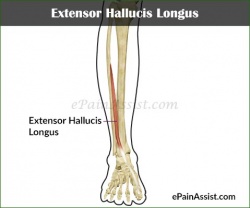Extensor Hallucis Longus
Introduction[edit | edit source]
The EHL is a thin muscle, situated between the Tibialis anterior and the Extensor digitorum longus.It is located on the lateral side of the leg .
Anatomy[edit | edit source]
Origin[edit | edit source]
From the Middle two quarters of the anterior surface of fibula and the adjecent interosseous membrane .
Insertion
[edit | edit source]
To the base of distal phalanx of the big toe .
Nerve Supply[edit | edit source]
Deep peroneal L4 , L5 ,S1 .
Action[edit | edit source]
Extends the metatasophalangeal and interphalangeal joints of the big toe and assist in the in the inversion of the foot and dorsiflexion of the ankle .
Palpation[edit | edit source]
Effect of Weakness[edit | edit source]
Weakness of EHL weaken extension at the metatarsophalangeal and interphalangeal joints .As it is the only muscle for the extension of interphalangeal joint so weakness of it is diagnostic for EHL weakness.
During normal locomotion, an individual contacts the ground with the heel of the foot first. The ground reaction force applies a plantarflexion moment to the whole foot, which is resisted by all of the dorsiflexors. Weakness of the EHL diminishes an individual’s ability to control the descent of the medial portion of the foot, particularly the great toe.
Patients with weakness of the extensor hallucis longus also report that the toe tends to fold under the foot when they are pulling on socks or shoes and can cause tripping.
Effect of Tightness[edit | edit source]
Tightness of the EHL pulls the metatarsophalangeal joint of the great toe into extension, which, as in the fingers and thumb, tends to produce flexion at the interphalangeal joint as the flexor hallucis longus is stretched, and a claw toe deformity emerges.
Hyperextension of the great toe pulls the plantar plate distally, exposing the metatarsal head to excessive loads and producing pain. Similarly, hyperextension of the metatarsophalangeal joint pulls the interphalangeal joint into the toe box of a shoe, causing pain and calluses, or corns, on the dorsal surface of the interphalangeal joint.







